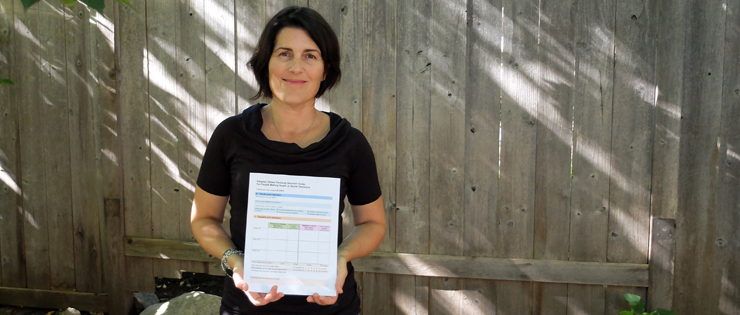Newsroom
Decision-making strategy aims to empower First Nations, Inuit and Métis patients
September 29, 2016

Postdoctoral fellow Dr. Janet Jull is tailoring and testing a peer-support shared decision-making strategy and guide to better meet the health-care needs of First Nations, Inuit and Métis.
While working as an occupational therapist with Inuit children in Nunavut and the Northwest Territories in the 1990s, Dr. Janet Jull realized that her tools weren’t always well suited to the task.
“One of the tasks was ‘Organize these blocks to look like a train,’” she said. “These kids had never seen a train in their lives. I asked them to make a Ski-Doo instead.”
That’s when she realized how health care could fail to meet the needs of First Nations, Inuit and Métis (FNIM) people. Today Dr. Jull, a postdoctoral fellow at The Ottawa Hospital and the University of Ottawa, is working with communities to develop shared decision-making strategies that work for FNIM populations.
FNIM people face increasing risks for cancer in relation to general populations. Poor detection and access to screening, as well as inadequate and culturally inappropriate care, are important issues. There is limited understanding of diverse FNIM cultures within the health-care system. Many people feel unsafe due to perceived racism, historic events or bad personal experiences.
Dr. Jull hopes that a peer-support shared decision-making strategy (which includes a guide), developed in collaboration with a local FNIM community and adapted from a tool originally created at The Ottawa Hospital, will empower FNIM people to participate in decisions about their health care.
The guide can be used by a trained peer-support worker and patient during a visit with a health-care provider. It will help define the decision, and consider the options and their harms and benefits. It also identifies patients’ values and preferences, as well as the support they need to access different options.
“It ensures people get the information to make the decision that is right for them,” said Dr. Jull, who has been awarded a fellowship from the Canadian Institutes of Health Research for the project.
Dr. Jull acknowledges that there is still a lot to be done to make the health-care experience better for FNIM people.
“This is not ‘the’ solution, but it’s a way to increase awareness and communication within the health-care system,” she said. “I’m hopeful, and my FNIM research partners say this is a good first step.”
ᓄᓇᖃᖅᑳᖅᓯᒪᔪᓕᒫᑦ ᐊᓪᓚᐃᑦ, ᐃᓄᐃᑦ ᐊᒻᒪᓗ ᐊᓪᓚᖓᔪᐃᑦ ᖃᑎᖃᑎᒌᓐᓂᒃᑯᑦ ᐋᖅᑭᓱᖅᑕᐃᓂᐊᕐᑐᑦ ᐊᑐᐊᒐᒃᓴᐅᒐᔭᖅᑐᒥᑦ

ᖃᐅᔨᓵᕆᓯᒪᔭᖓᓄᑦ ᐃᓕᓴᕆᔭᐅᓯᒪᔪᖅ ᓘᑦᑖᖅ ᔭᓇᑦ ᔫᓪ ᐋᖅᑭᓱᐃᕙᓪᓕᐊᖕᒪᑦ ᐊᑐᐊᒐᒃᓴᐅᒐᔭᖅᑐᖅᒥ ᖃᓄᖅ ᓄᓇᖃᖅᑳᖅᓯᒪᔪᓕᒫᑦ ᐃᑲᔪᖅᑕᐅᑦᑎᐊᒃᑲᓐᓂᕈᓐᓇᒪᖔᑕ ᐋᓐᓂᐊᖅᑐᓕᕆᓂᕕᓐᓂ.
ᔮᓇᑦ ᔫᓪ ᐃᖅᑲᓇᐃᔮᖃᓚᐅᕐᑎᓪᓗᒍ ᐃᓄᐃᑦ ᓱᕈᓯᖏᓐᓂ ᐋᓐᓂᐊᕕᓐᓂ ᓄᓇᕗᒻᒥ ᐊᒻᒪᓗ ᓄᓇᑦᓯᐊᕐᒥ, ᓘᑦᑖᖅ ᔮᓇᑦ ᔫᓪ ᖃᐅᔨᓚᐅᖅᑐᖅ ᐊᑐᖅᑕᖏᑦ ᓈᒻᒪᓚᐅᖏᒻᒪᑕ.
“ᐃᓚᖓ ᐊᑐᕐᑕᐅᓪᓗᓂ “ᕿᔪᑲᓪᓚᓂᑦ ᐊᑐᕐᑐᓂ ᓄᓇᓯᐅᑎᑯᑖᓐᖑᐊᒥᑦ ᐋᖅᑭᓱᖁᔨᓪᓗᓂ” ᐅᖃᖅᑐᓂ. “ᓄᓇᑲᒃᑰᕈᑎᑯᑖᒥᑦ ᑕᑯᓚᐅᕐᓯᒪᖏᓐᓂᖏᓐᓄᑦ ᐊᐱᕆᓕᓚᐅᑕᖏᑦ ᓯᑭᑑᓐᖑᐊᒥᑦ ᓴᓇᖁᖔᓕᖅᑐᒋᑦ.”
ᖃᐅᔾᔨᐊᓪᓚᓚᐅᕐᑐᖅ ᐋᓐᓂᐊᖅᑐᓕᕆᓂᐅᑉ ᒪᓕᒐᖏᑦ ᐊᑑᑎᖃᑦᑎᐊᔮᖏᒻᒪᑦ ᑐᕌᖓᖏᑉᐸᑕ ᓄᓇᖃᖅᑳᖅᑐᓕᒫᓄᑦ ᐊᓪᓚᓄᑦ, ᐃᓄᓐᓄᑦ ᐊᒻᒪᓗ ᐊᓪᓚᖓᔪᓄᑦ. ᐅᓪᓗᒥ, ᓘᑦᑖᖅ ᔫᓪ, ᖃᐅᔨᓵᒥᓄᑦ ᐃᓕᓴᕆᔭᐅᓯᒪᔪᖅ ᐋᑐᕚ ᐋᓐᓂᐊᕕᐊᓂ ᐊᒻᒪᓗ ᐋᑐᕚ ᐃᓕᓐᓂᐊᕐᕕᔾᔪᐊᖓᓂ, ᐱᓕᕆᖃᑎᖃᕐᑐᖅ ᓄᓇᓕᖕᓂ ᐋᖅᑭᔅᓱᐃᒐᓱᐊᕐᑐᑎ ᐃᑲᔪᖃᑎᒌᓐᓂᒃᑯᑦ ᐊᑐᕈᑕᐅᒐᔭᕐᑐᓂᑦ ᑐᕌᔪᓂ ᓄᓇᖃᑦᑳᖅᓯᒪᔪᓄᑦ ᓄᓇᓕᐅᔪᓂ.
ᓄᓇᖃᖅᑳᖅᓯᒪᔪᐃᑦ ᐋᓐᓂᐊᑖᖅᐸᓪᓕᐊᔪᑦ ᐅᓄᕐᓂᓴᒻᒪᕆᐊᓘᒻᒪᑕ ᐃᓄᖕᓂᑦ ᐊᓯᖏᓐᓂ ᓄᓇᖃᖅᑳᖅᓯᒪᖏᑐᓐᓂ. ᖃᐅᔨᓴᖅᑕᐅᑦᑎᐊᖃᑦᑕᖏᓐᓂᖏᓐᓄᑦ ᐊᒻᒪᓗ ᖃᐅᔨᓴᕈᑎᖏᑦ ᐃᓕᖅᑯᓯᖏᓐᓄᑦ ᑐᕌᖓᔪᓂᑦ ᐊᑐᐃᓐᓇᐅᖏᓗᐊᕐᓂᖏᓐᓄᑦ, ᑕᒪᒃᑯᐊ ᐱᒻᒪᕆᐊᓘᑎᓪᓗᒋ. ᐋᓐᓂᐊᖅᑐᓕᕆᔩᑦ ᑐᑭᓯᓯᒪᖏᓗᐊᕐᒪᑕ ᓄᓇᖃᖅᑳᖅᑐᒥᓃᑦ ᐃᓕᖅᑯᓯᖏᓐᓂ. ᐊᒥᓲᔪᑦ ᑲᑉᐱᐊᓱᖃᑦᑕᒻᒪᑕ ᑭᒃᑰᓂᖏᑕ ᑕᑯᓐᓇᖅᑕᐅᓂᖏᓐᓄᑦ, ᐃᓕᖅᑯᓯᖏᑎᒍᑦ ᓱᔭᐅᑲᒻᒪᓯᒪᓂᖏᒍᑦ ᐅᕝᕙᓘᓐᓃᑦ ᐊᑐᑲᒻᒪᓯᒪᔭᖏᑎᒍᑦ ᐱᔾᔪᑎᖃᖅᑐᑎ.
ᓘᑦᑖᖅ ᔫᓪ ᑕᑯᒍᒪᔪᖅ ᐱᓕᕆᖃᑎᒌᓐᓂᒃᑯᑦ ᓄᓇᖃᖅᑳᖅᓯᒪᔪᓄᑦ ᐋᖅᑭᑦᑕᐅᔪᒥ ᐊᑐᐊᒐᒃᓴᐅᒐᔭᖅᑐᖅ (ᐃᓚᖃᕐᓗᓂ ᒪᓕᒐᕐᒥ) ᐊᒻᒪᓗ ᐊᑐᕐᓗᑎ ᐋᑐᕚ ᐋᓐᓂᐊᕕᖓᑕ ᐊᑐᐊᒐᖏᓐᓂ ᐋᖅᑭᓱᐃᓗᑎ ᓄᓇᖃᖅᑳᖅᑐᒥᓂᕐᓄᑦ ᑐᕌᖓᔪᓂᑦ ᐋᓐᓂᐊᑐᓕᕆᓂᕐᒥᑦ ᐱᔾᔪᑎᓕᑦ.
ᒪᓕᒐᒃᓴᖅ ᐋᖅᑭᓱᖅᑕᐅᒐᔭᕐᓗᓂ ᐃᖃᓇᐃᔭᖅᑎᒥ ᐃᑲᔪᕐᑎᒥ ᐃᓕᓐᓂᐊᖅᓯᒪᑦᑎᐊᕐᑐᒥ ᐊᒻᒪᓗ ᐋᓐᓂᐊᕕᓕᐊᖅᓯᒪᔪᒧᑦ. ᐊᖏᒍᑕᐅᔪᑦ ᑲᔪᓯᑦᑎᐊᖁᓪᓗᒋᑦ, ᐊᒻᒪᓗ ᕿᒥᕐᕈᔭᐅᓗᑎ ᐊᑐᐊᒐᒃᓴᐃᑦ ᐊᒻᒪᓗ ᐊᑦᑕᓇᕐᓂᕆᒐᔭᖅᑕᖏ ᐊᒻᒪᓗ ᐱᐅᓂᖏᑦ. ᓴᖅᑮᓂᐊᕐᒪᑦ ᐋᓐᓂᐊᕕᓕᐊᖅᓯᒪᔫᑉ ᐃᓱᒪᒋᔭᖏᑦ ᐊᒻᒪᓗ ᐱᖁᔭᖏᑦ, ᐊᒻᒪᓗᑦᑕᐅ ᐊᔾᔨᒌᖏᑦᑐᓂ ᐊᑐᕋᒃᓴᐅᒐᔭᖅᑐᓂᑦ ᓴᖅᑮᖃᑕᐅᓗᓂ.
“ᖃᐅᔨᒪᔭᐅᔭᕆᐊᓖᑦ ᐋᖅᑭᑕᐅᑦᑎᐊᖁᓪᓗᒋᑦ ᑐᕌᖓᔪᑦ ᓄᓇᖃᖅᑳᖅᑐᒥᓂᕐᓄᑦ,” ᐅᖃᖅᑐᖅ ᓘᑦᑖᖅ ᔫᓪ, ᑐᓂᔭᐅᓯᒪᔪᑦ ᖃᐅᔨᓴᕈᑎᒋᓯᒪᔭᖓᓄᑦ ᑲᓇᑕᐅᑉ ᐋᓐᓂᐊᖅᑐᓕᕆᕕᖏᓐᓂ ᖃᐅᔨᓴᖅᕕᑦ.
ᓘᑦᑖᖅ ᔫᓪ ᓇᓗᓇᐃᖅᓯᔪᖅ ᐱᓕᕆᐊᒃᓴᓕᒻᒪᕆᐊᓘᒻᒪᑕᒎᖅ ᓱᓕ ᐋᓐᓂᐊᖅᑐᓕᕆᓂᕐᒥᑦ ᖃᓄᖅ ᐊᑲᐅᓯᕚᓪᓕᑎᒃᑲᓐᓂᕈᓐᓇᓂᕐᒥ ᑐᕌᖓᔪᓂᑦ ᓄᓇᖃᖅᑳᖅᓯᒪᔪᓄᑦ.
“ᑕᒪᓐᓇ ᐋᖅᑮᔮᖏᑦᑐᖅ, ᑭᓯᐊᓂᓕ ᖃᐅᔨᕚᓪᓕᑎᑦᑎᐊᓂᕐᑐᖅ ᖃᐅᔨᒪᔭᐅᔭᕆᐊᓕᖕᓂ ᐊᒻᒪᓗ ᓂᓪᓕᐊᖃᑎᒌᑦᑎᐊᕈᑎᒃᓴᓂ ᐋᓐᓂᐊᖅᑐᓕᕆᕕᓐᓂ,” ᐅᖃᖅᑐᖅ. “ᐅᑉᐱᕈᓱᑉᐳᖅ, ᐊᒻᒪᓗ ᓄᓇᖃᖅᑳᖅᓯᒪᔪᑦ ᐱᓕᕆᖃᑎᒋᔭᒃᑲ ᖃᐅᔨᓴᕐᓂᐊᐅᔪᒥᑦ ᓈᒻᒪᓴᕐᐳᑦ.”
The Ottawa Hospital: Inspired by research. Driven by compassion
The Ottawa Hospital is one of Canada’s largest learning and research hospitals with over 1,100 beds, approximately 12,000 staff and an annual budget of over $1.2 billion. Our focus on research and learning helps us develop new and innovative ways to treat patients and improve care. As a multi-campus hospital, affiliated with the University of Ottawa, we deliver specialized care to the Eastern Ontario region, but our techniques and research discoveries are adopted around the world. We engage the community at all levels to support our vision for better patient care. See www.ohri.ca for more information about research at The Ottawa Hospital.
University of Ottawa
The University of Ottawa is home to over 50,000 students, faculty and staff, who live, work and study in both French and English. Our campus is a crossroads of cultures and ideas, where bold minds come together to inspire game-changing ideas. We are one of Canada’s top 10 research universities—our professors and researchers explore new approaches to today’s challenges. One of a handful of Canadian universities ranked among the top 200 in the world, we attract exceptional thinkers and welcome diverse perspectives from across the globe. www.uottawa.ca
For further information, please contact
Amelia Buchanan
Senior Communication Specialist
Ottawa Hospital Research Institute
Office: 613-798-5555 x 73687
Cell: 613-297-8315
ambuchanan@ohri.ca
